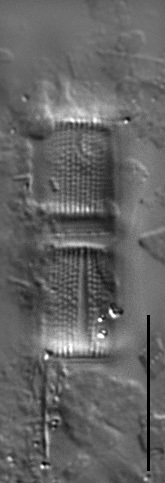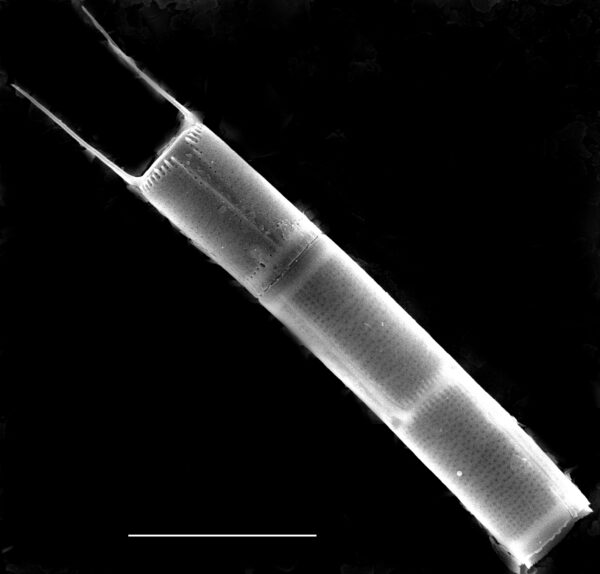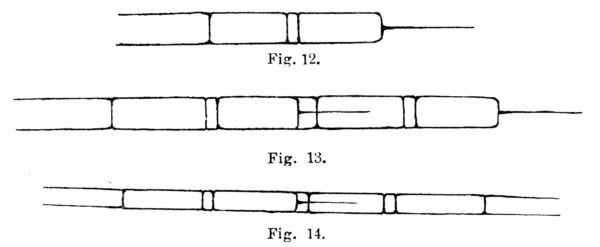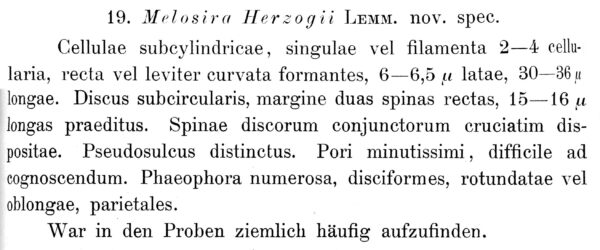Aulacoseira herzogii
-
Category
-
Diameter3-7 µm
-
Width Range7-14 µm
-
Striae in 10 µm30-32
-
ContributorMarina Potapova, Jonathan English - Dec 2010
-
ReviewerMark Edlund - Feb 2011
Identification
Description
Frustules are cylindrical and form short colonies, usually of two frustules. Valves are 3-7 µm in diameter and have a mantle height between 7-14 µm. The ratio of mantle height to valve diameter is either equal to, or greater than, 1. The mantle is straight and the valve face is either flat or slightly radially undulate with a concave center. Small areolae are present on the valve face. The straight rows of mantle areolae are often not resolvable in LM and number 30-32 per 10 µm. These small areolae, if visible in the light microscope, appear circular, although they are irregularly shaped under SEM and number 27-37 per 10 µm along the pervalvar row. Two diametrically opposed grooves, containing no areolae, extend the entire length of the valve. Two large, pointed separation spines diametrically opposed on the valve face extend in the plane of the mantle onto grooves of the neighboring frustules. The planes of the large spines and the grooves are at right angles to each other. Smaller, broadly pointed spines are present at the end of each costa. No valves with linking spines have been observed. The ringleiste is relatively shallow. According to Hickel & H. Håkansson (1991) the number of spines may be 2-4, but specimens that we observed from the U.S. had 2 spines.
Original Description
Cellulae subcylindricae, singulae vel filamenta 2—4 cellu-laria, recta vel leviter curvata formantes, 6—6,5 μ latae, 30—36 μ longae. Discus subcircularis, margine duas spinas rectas, 15—16 μ longas praeditus. Spinae discorum conjunctorum cruciatim dis-positae. Pseudosulcus distinctus. Pori minutissimi, difficile ad cognoscendum. Phaeophora numerosa, disciformes, rotundatae vel oblongae, parietales.
-
BasionymMelosira herzogii
-
AuthorLemmerm. 1910
Citations & Links
Citations
-
Publication Link: 10.1080/0269249X.1991.9705175
-
Publication Link: 10.1080/0269249X.1993.9705270
Links
-
Index Nominum Algarum
-
North American Diatom Ecological DatabaseNADED ID: 10038
Cite This Page
Potapova, M., English, J. (2010). Aulacoseira herzogii. In Diatoms of North America. Retrieved April 19, 2024, from https://diatoms.org/species/aulacoseira_herzogii
Responses
The 15 response plots show an environmental variable (x axis) against the relative abundance (y axis) of Aulacoseira herzogii from all the stream reaches where it was present. Note that the relative abundance scale is the same on each plot. Explanation of each environmental variable and units are as follows:
ELEVATION = stream reach elevation (meters)
STRAHLER = distribution plot of the Strahler Stream Order
SLOPE = stream reach gradient (degrees)
W1_HALL = an index that is a measure of streamside (riparian) human activity that ranges from 0 - 10, with a value of 0 indicating of minimal disturbance to a value of 10 indicating severe disturbance.
PHSTVL = pH measured in a sealed syringe sample (pH units)
log_COND = log concentration of specific conductivity (µS/cm)
log_PTL = log concentration of total phosphorus (µg/L)
log_NO3 = log concentration of nitrate (µeq/L)
log_DOC = log concentration of dissolved organic carbon (mg/L)
log_SIO2 = log concentration of silicon (mg/L)
log_NA = log concentration of sodium (µeq/L)
log_HCO3 = log concentration of the bicarbonate ion (µeq/L)
EMBED = percent of the stream substrate that is embedded by sand and fine sediment
log_TURBIDITY = log of turbidity, a measure of cloudiness of water, in nephelometric turbidity units (NTU).
DISTOT = an index of total human disturbance in the watershed that ranges from 1 - 100, with a value of 0 indicating of minimal disturbance to a value of 100 indicating severe disturbance.
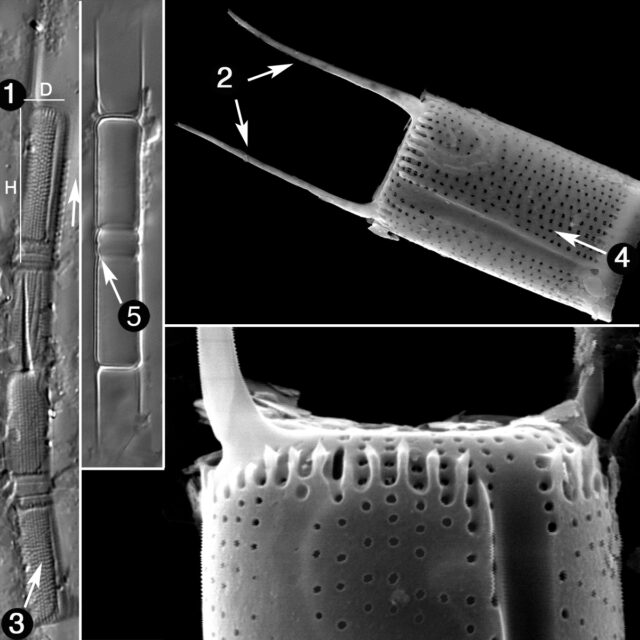
Aulacoseira herzogii
- Ratio of mantle height to valve diameter >= 1
- Valves with 2(4) long spines
- Mantle areolae hardly visible in LM
- Rows of mantle areolae straight
- Ringleiste shallow
Valves are 3-7 µm in diameter and have a mantle height between 7-14 µm. The ratio of mantle height to valve diameter is either equal to, or greater than, 1. The straight rows of mantle areolae are often not resolvable in the light microscope and number 30-32 per 10 µm. These small areolae, if visible in LM, appear circular, 27-37 per 10...
 Diatoms of North America
Diatoms of North America



